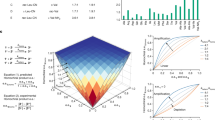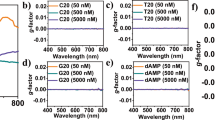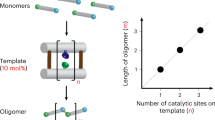Abstract
Theories of the origin of optical asymmetry in living systems place fundamental importance on the amplification of optical asymmetry by an autocatalytic process1–3. The replication of a polynucleotide is one obvious choice for such an autocatalytic growth mechanism. If an optically homogeneous polynucleotide could replicate by directing the polymerization of monomers of the same handedness, while excluding monomers of the opposite handedness, its chiral descendants would come to dominate what was once an achiral environment. Recently, two highly efficient template-directed reaction systems have been developed for the oligomerization of activated guanosine mononucleotides (Fig. 1) on a poly(C) template4,5. The synthesis of L-guanosine 5′-mononucleotide6 makes it possible to study chiral selection in these systems. We report here that poly(C)-directed oligomerization of activated guanosine mononucleotides proceeds readily if the monomers are of the same optical handedness as the template, and is indeed far less efficient if the monomers are of the opposite handedness. However, in template-directed reactions with a racemic mixture, monomers of the opposite handedness to the template are incorporated as chain terminators at the 2′(3′) end of the products. This inhibition raises an important problem for many theories of the origin of life.
This is a preview of subscription content, access via your institution
Access options
Subscribe to this journal
Receive 51 print issues and online access
$199.00 per year
only $3.90 per issue
Buy this article
- Purchase on Springer Link
- Instant access to full article PDF
Prices may be subject to local taxes which are calculated during checkout
Similar content being viewed by others
References
Wald, F. Ann. N.Y. Acad. Sci. 69, 352–368 (1957).
Bonner, W. A., Blair, N. E. & Dirbas, F. M. Origins of Life 11, 119–134 (1981).
Fajszi, C. & Czege, J. Origins of Life 11, 143–162 (1981).
Bridson, P. K. & Orgel, L. E. J. molec. Biol. 144, 567–577 (1980).
Inoue, T. & Orgel, L. E. J. molec. Biol. 162, 204–217 (1982).
Visser, G. M., van Westrenen, J., van Boeckel, C. A. A. & van Boom, J. H. Recl Trav. chim. Pays-Bas Belg. (in the press).
Lohrmann, R. & Orgel, L. E. J. molec. Biol. 142, 555–567 (1980).
Fakhrai, H., Inoue, T. & Orgel, L. E. Tetrahedron 40, 39–45 (1984).
Howard, F. B., Frazier, J., Lipsett, M. N. & Miles, H. T. Biochem. biophys. Res. Commun. 17, 93–102 (1964).
Ts'o, P. O. P. Basic Principles in Nucleic Acid Chemistry Ch. 6 (Academic, New York, 1974).
Inoue, T. & Orgel, L. E. J. Am. chem. Soc. 103, 7666–7667 (1981).
Author information
Authors and Affiliations
Rights and permissions
About this article
Cite this article
Joyce, G., Visser, G., van Boeckel, C. et al. Chiral selection in poly(C)-directed synthesis of oligo(G). Nature 310, 602–604 (1984). https://doi.org/10.1038/310602a0
Received:
Accepted:
Issue Date:
DOI: https://doi.org/10.1038/310602a0
This article is cited by
-
Flow-induced periodic chiral structures in an achiral nematic liquid crystal
Nature Communications (2024)
-
Synthesis and applications of mirror-image proteins
Nature Reviews Chemistry (2023)
-
Biological effects of the loss of homochirality in a multicellular organism
Nature Communications (2022)
-
On the Origin of Sugar Handedness: Facts, Hypotheses and Missing Links-A Review
Origins of Life and Evolution of Biospheres (2022)
-
Evolutionary Approach to Biological Homochirality
Origins of Life and Evolution of Biospheres (2022)
Comments
By submitting a comment you agree to abide by our Terms and Community Guidelines. If you find something abusive or that does not comply with our terms or guidelines please flag it as inappropriate.



